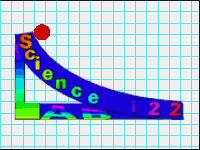 |
Science 122Laboratory |
 |
 |
Science 122Laboratory |
 |
Multiplying by ten adds a zero (2 x 10 = 20) or moves the decimal point to the right (2.72 x 10 = 27.2)
Dividing by ten subtracts a zero (20/10 = 2) or moves the decimal point to the left (27.2/10 = 2.72)
HOW TO DO IT: Zeros |
Count how many zeros in the number.Make that number a power of ten.Multiply the first digit by that power of ten. |
|||
2 zeros --> 10 x 10 --> 102 |
100 = 1 x 102 |
200 = 2 x 102 |
300 = 3 x 102 |
400 = 4 x 102 |
3 zeros --> 10 x 10 x 10 --> 103 |
1000 = 1 x 103 |
2000 = 2 x 103 |
3000 = 3 x 103 |
4000 = 4 x 103 |
4 zeros --> 10 x 10 x 10 x 10 --> 104 |
10000 = 1 x 104 |
20,000 = 2 x 104 |
30,000 = 3 x 104 |
40,000 = 4 x 104 |
HOW TO DO IT: Decimals |
Place the decimal point after the first significant digit.Count how many digits, including zeros to the right or left of the decimal point.Make that number a power of ten.Multiply the resulting number by that power of ten. |
|||
2 decimals --> 10 x 10 --> 102 |
176 = 1.76 x 102 |
241 = 2.41 x 102 |
327 = 3.27 x 102 |
496 = 4.96 x 102 |
3 decimals --> 10 x 10 x 10 --> 103 |
1762 = 1.762 x 103 |
2417 = 2.417 x 103 |
3274 = 3.274x 103 |
4963 = 4.963 x 103 |
4 decimals --> 10 x 10 x 10 x 10 --> 104 |
17,625 = 1.7625 x 104 |
24,178 = 2.41 x 102 |
32,741 = 3.2741 x 104 |
49,632 = 4.9632 x 104 |
- Example: 249.8 is rounded to 3 significant figures to become 2.50 x 102
- Example: the average distance from the Sun to the Earth is 93,000,000 mi.
Using powers-of-ten notation, this can be written as
93,000,000 miles = 9.3 x 10^7 mi or 9.3 x107 mi